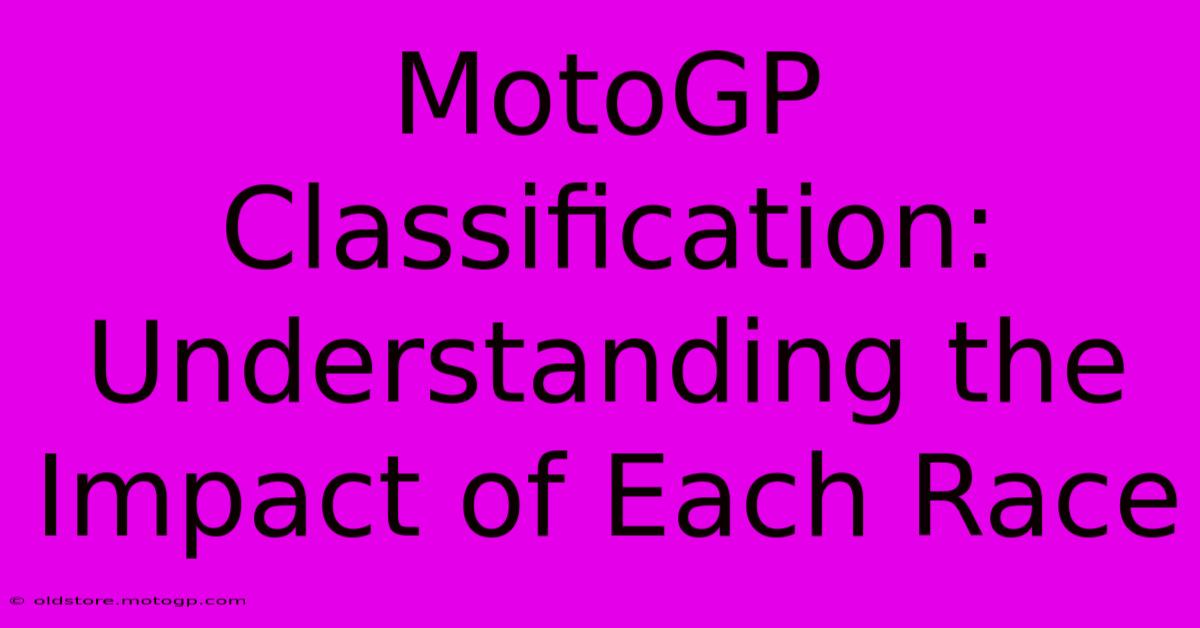MotoGP Classification: Understanding The Impact Of Each Race

Table of Contents
MotoGP Classification: Understanding the Impact of Each Race
MotoGP, the pinnacle of motorcycle racing, captivates millions with its speed, skill, and drama. But understanding the intricacies of the championship classification system is crucial for truly appreciating the sport's intensity. Each race, from the thrilling sprints to the grueling endurance tests, significantly impacts the overall standings, creating a captivating narrative that unfolds throughout the season. This article delves into how each race contributes to the final MotoGP classification.
The Point System: A Foundation of Competition
The foundation of the MotoGP classification rests on a points system awarded at the end of each race. The rider finishing first receives the most points (25 in 2023), with points decreasing for subsequent positions. This system incentivizes riders to push for every position, even in the lower echelons of the race. The precise points allocation varies slightly between different MotoGP classes (MotoGP, Moto2, and Moto3), but the principle remains the same: consistent strong finishes accumulate vital points towards the championship title.
Points Breakdown (Illustrative Example - 2023 MotoGP):
- 1st Place: 25 points
- 2nd Place: 20 points
- 3rd Place: 16 points
- 4th Place: 13 points
- 5th Place: 11 points
- 6th Place: 10 points
- 7th Place: 9 points
- 8th Place: 8 points
- 9th Place: 7 points
- 10th Place: 6 points
- 11th Place: 5 points
- 12th Place: 4 points
- 13th Place: 3 points
- 14th Place: 2 points
- 15th Place: 1 point
Sprint Races: Adding an Extra Layer of Competition
Introduced in 2023, the sprint races add a new dynamic to the weekend. These shorter races, held on Saturday, award points to the top nine finishers, further influencing the championship battle. While the points awarded for sprint races are less than the main race, they provide crucial opportunities for riders to gain an advantage and potentially close the gap on their rivals. A strong performance in the sprint can build momentum and confidence heading into the main race on Sunday. The strategic importance of sprint races cannot be underestimated.
The Impact of Consistency: More Than Just Wins
While race wins are obviously significant, consistency is equally crucial in determining the final classification. Regularly scoring points, even without securing victories, can build a substantial advantage over the course of a season. A rider who consistently finishes in the top five or top ten will accumulate a large number of points, potentially surpassing a rider who wins a few races but has more inconsistent performances in other rounds. Consistency is king in the MotoGP world championship.
The Importance of Qualifying: Setting the Stage for Success
Qualifying sessions aren't just about securing pole position. A strong qualifying performance sets the stage for a better race result. Starting further up the grid improves the chances of a top finish, leading to more points. A bad qualifying performance can put a rider on the back foot, making it harder to fight through the pack and score valuable points. Qualifying is the crucial first step in the race weekend's point-scoring mission.
Beyond Points: The Importance of Championship Momentum
The championship battle isn't solely about numerical points; it's also about momentum and psychological factors. A string of strong performances can boost a rider's confidence and potentially demoralize their rivals. Conversely, a series of poor results can create a negative spiral, impacting both performance and mental strength. The intangible aspects of the championship race are just as crucial as the points themselves.
Conclusion: A Complex Equation for Glory
The MotoGP classification is a complex equation where points from each race, sprint race performance, qualifying results, and even the intangible aspects of momentum combine to determine the champion. Understanding the impact of each individual race, each lap, and each decision emphasizes the incredible skill, strategy, and relentless competition that defines the world of MotoGP. The fight for the championship title is not decided in one race, but rather over a grueling season-long battle.

Thank you for visiting our website wich cover about MotoGP Classification: Understanding The Impact Of Each Race. We hope the information provided has been useful to you. Feel free to contact us if you have any questions or need further assistance. See you next time and dont miss to bookmark.
Featured Posts
-
Push Your Limits Race Motorcycles For Sale
Feb 20, 2025
-
Moto Gp Streams Catch Every Practice Session Live
Feb 20, 2025
-
Any Racing On Tv Today Your Weekend Entertainment
Feb 20, 2025
-
Moto2 Bike Specs What Makes These Bikes So Special
Feb 20, 2025
-
Top Speed Moto Gp Bike The Ultimate Adrenaline Rush
Feb 20, 2025
